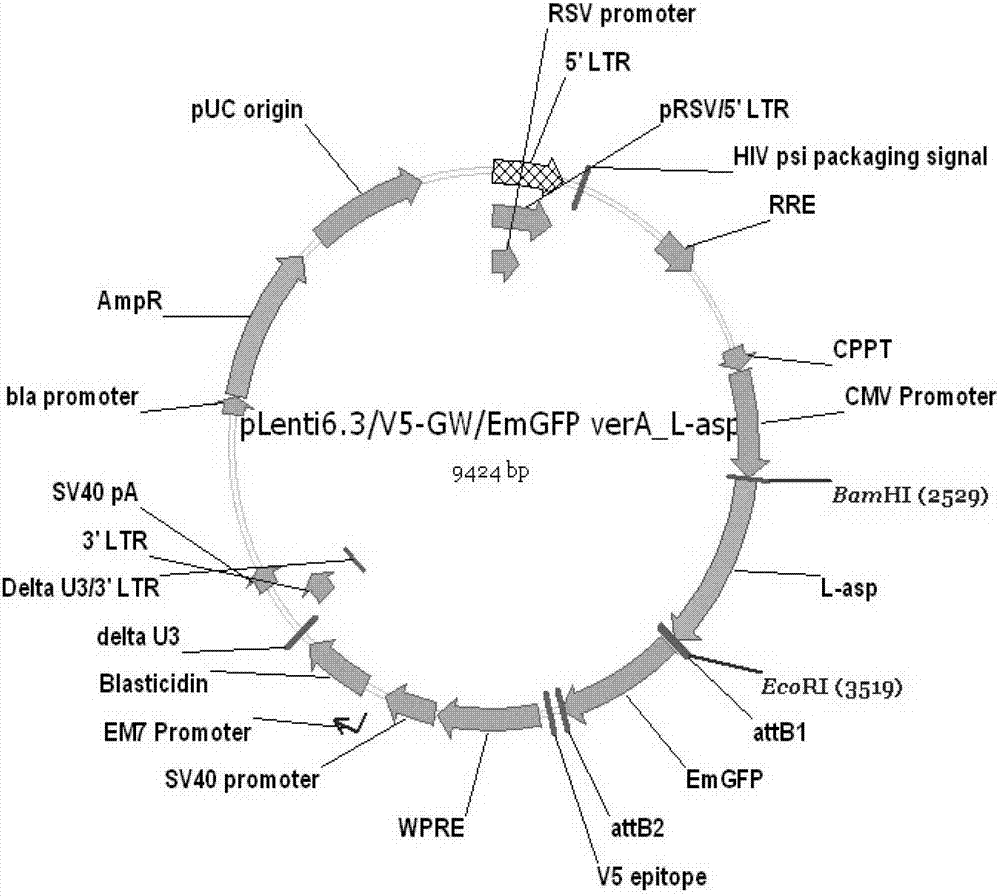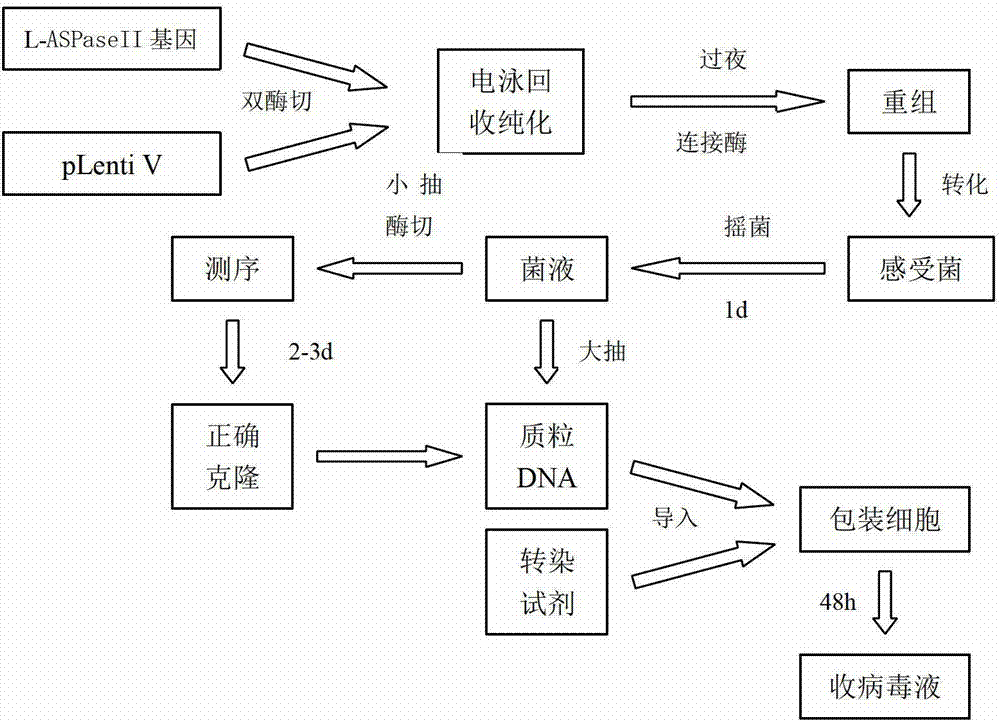Method for inducing in vitro the generation of erythrocyte medicine containing l-aspase II
A technology of erythrocytes and drugs, applied in the field of regenerative medicine, can solve the problems of reduced deformability of carrier erythrocytes, increased fragility of carrier erythrocytes, damage of carrier erythrocyte membranes, etc., and achieve the effect of reducing toxic and side effects
- Summary
- Abstract
- Description
- Claims
- Application Information
AI Technical Summary
Problems solved by technology
Method used
Image
Examples
Embodiment 1
[0031] Example 1: Construction and packaging of lentiviral vector
[0032] The Escherichia coli L-asparaginase II gene sequence (981bp, the last group is terminator) and amino acid sequence (326aa) were obtained from NCBI, as shown in 1 and 2 in the sequence table.
[0033] The experimental process of lentiviral vector construction is as follows (the process is as follows: figure 2 shown):
[0034] 1) Construction of cloning vector: the target gene L-asparaginase II gene was synthesized by Nanjing GenScript Biotechnology Co., Ltd., and the target gene was connected to the pUC57 vector through BamH I and EcoR I restriction sites to construct a cloning vector pUC57-L-ASPase II.
[0035] 2) Construction of expression vector: plasmid pUC57-L-ASPase II and vector plasmid pLenti6.3 / V5-GW / Em-GFPVerA (Invitrogen) were simultaneously digested with BamH I and EcoR I enzymes, enzyme digestion system: 10x buffer 2 μl , 0.4 μl each of BamH I and EcoR I, 4 μl of plasmid solution (plasmi...
Embodiment 2
[0050] Example 2: Genetic modification of IPS cells using lentiviral vectors
[0051] 1) Plating: Digest and resuspend the IPS in the logarithmic growth phase with 0.05% trypsin in PBS, press 1*10 5 / ml density inoculated in 12-well plate, grown overnight (12h).
[0052] 2) Infection: Aspirate 70-80% of the culture solution in the 12-well plate, replace with fresh culture solution, and add virus solution diluted in PBS concentration gradients at the same time (5 gradients in total, prepare 5 1.5ml EP tubes, Add 90 μl PBS to each tube, add 10 μl virus stock solution to the first tube, mix well, pipette 10 μl into the second tube and mix well, and so on, make 5 dilutions (10~10 -4 )), mix well and put in 37℃, 5%CO 2 cultured in an incubator. 3) Change the medium after 24 hours of culture, and you can see the fluorescence after 48 hours. Place the cells on the MEF trophoblast cells for low-density culture (1*10 4 / ml), 12-14 days later, the clones were picked for the next ste...
Embodiment 3
[0053] Example 3: Inducing IPS cells in vitro to generate erythrocyte drugs containing L-ASPase II
[0054] 1) In vitro differentiation of IPS cells into EBs (Erythroid Body)
[0055] Human IPS cells (hIPS) (prepared in Example 2) passaged for 12 to 30 passages were digested with collagenase IV (collagenase IV), and then transferred to a culture medium prepared with IMDM (Biochrome) as the base culture medium. In the culture medium Contains SCF (Sigma, 100ng / mL), TPO (Sigma, 100ng / mL), FLT3 ligand (Sigma, 100ng / mL), BMP4 (Peprotech, 10ng / mL), VEGF-A165 (Sigma, 5ng / mL), IL -3 (Sigma, 5ng / mL), IL-6 (Peprotech, 5ng / mL) and erythropoietin EPO (Sigma, 3U / mL); cells were placed at 37°C, 5% CO 2 EBs were cultured for 20 days under conditions; after the formation of EBs, the cells were digested with collagenase B (Sigma, 0.4 U / mL) at 37°C for 30 minutes and placed in buffer (invitrogen) for 10 minutes.
[0056] 2) EB induces differentiation into mature red blood cells
[0057] ① Af...
PUM
| Property | Measurement | Unit |
|---|---|---|
| diameter | aaaaa | aaaaa |
Abstract
Description
Claims
Application Information
 Login to View More
Login to View More - R&D
- Intellectual Property
- Life Sciences
- Materials
- Tech Scout
- Unparalleled Data Quality
- Higher Quality Content
- 60% Fewer Hallucinations
Browse by: Latest US Patents, China's latest patents, Technical Efficacy Thesaurus, Application Domain, Technology Topic, Popular Technical Reports.
© 2025 PatSnap. All rights reserved.Legal|Privacy policy|Modern Slavery Act Transparency Statement|Sitemap|About US| Contact US: help@patsnap.com



